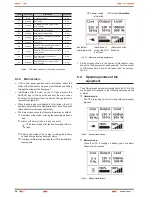
23
SALICRU
The label will have the following text or an equivalent one:
Before working on this circuit.
Ŗ
Isolate Uninterruptible Power System (UPS).
Ŗ
Then check for Hazardous Voltage between all
terminals including the protective earth.
Risk of Voltage Backfeed from UPS.
Connect the power supply cables to input power blocks
R
(L)
, and
N
, by respecting the phase and neutral rotation
stated in the labelling of the equipment and in this
manual (see figure 13)
. If this rotation is not respected,
serious faults could happen.
When discrepancies exist between the labelling and the
instructions of this manual, the labelling will always prevail.
In parallel systems, the length and cross section
of the cables that go from the switchgear panel till
one of the UPSs and vice versa, will be the same for all of
them without any exception.
4.3.2. Connection of the static bypass
power blocks (> 3 kVA models
power rate only).
Ŗ
These equipments have separate power blocks for the
static bypass line. For installations with two power sup-
plies, the cable as a bridge mode "Jumper" between the termi-
nals
JP
and
L
(bypass phase line) doesn't need to be fitted,
otherwise a short-circuit can be made when turning on the
protection of both lines.
Ŗ
As this is a device with class I protection against elec-
tric shocks, it is essential to install a protective earth
conductor (connect earth(
)
). Connect the conductor to
the terminal, before connecting the power supply to the input
power block.
R (L)
N
U (L)
N
(1)
(3)
(2)
SAI
«Backfeed protection» connection for TWIN RT > 3 kVA
with static bypass line (no Jumper).
«Backfeed protection» connection for TWIN RT > 3 kVA
with no static bypass line (Jumper fitted in.
(3)
(2)
(1)
SAI
In
p
u
t
Out
put
Output
In
put
Bypass
(1)
Automatic «Backfeed protection» protection system, external to the UPS (EN-IEC 62040-1).
(2)
Fuse holder and fuse for general purpose of 250V AC / 3A type F.
(3)
Two poles contactor of 230V AC with a minimum distance between contact of 1,4 mm and coil of the same voltage, with the minimum current stated
in the nameplate of the UPS (input or bypass according to).
i
For parallel systems, each equipment must have its own "Backfeed protection" completely independent.
R (L)
N
R (L)
N
U (L)
N
R (L)
N
JP
Cable as bridge
mode "Jumper"
factory installed
default
Fig. 12.
Wiring diagram for “Backfeed protection”.
Ŗ
In accordance with safety standard EN-IEC 62040-1, the in-
stallation has to be provided with a «Backfeed protection»
system, as for example a contactor, which will prevent the
appearance of voltage or dangerous energy at the bypass
line during a mains fault (see figure 12 and respect the cir-
cuit diagram of the particular «Backfeed protection» for the
equipment with bypass line.
There can be no derivation in the line that goes from
the «Backfeed protection» to the UPS, as the safety
standard would be infringed.
Ŗ
Warning labels should be placed on all primary power
switches installed in places away from the device to alert the
electrical maintenance personnel of the presence of a UPS
in the circuit.
The label will have the following text or an equivalent one:
Before working on this circuit.
Ŗ
Isolate Uninterruptible Power System (UPS).
Ŗ
Then check for Hazardous Voltage between all
terminals including the protective earth.
Risk of Voltage Backfeed from UPS.
Ŗ
Connect the power supply cables to input power blocks
R (L)
,
and
N
, by respecting the phase and neutral rotation
stated
in the labelling of the equipment and in this manual (see
figure 13)
. If this rotation is not respected, serious faults
could happen.
When discrepancies exist between the labelling and the in-
structions of this manual, the labelling will always prevail.
Ŗ
In parallel systems, the length and cross section of the
cables that go from the switchgear panel till one of the
UPSs and vice versa, will be the same for all of them without
any exception.
















































